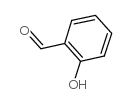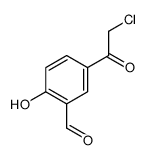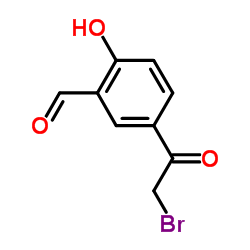Salbutamol

Salbutamol structure
|
Common Name | Salbutamol | ||
|---|---|---|---|---|
| CAS Number | 18559-94-9 | Molecular Weight | 239.311 | |
| Density | 1.2±0.1 g/cm3 | Boiling Point | 433.5±40.0 °C at 760 mmHg | |
| Molecular Formula | C13H21NO3 | Melting Point | 157-158ºC | |
| MSDS | Chinese USA | Flash Point | 159.5±17.9 °C | |
| Symbol |

GHS07 |
Signal Word | Warning | |
Use of SalbutamolSalbutamol is a short-acting β2-adrenergic receptor agonist used for the relief of bronchospasm in conditions such as asthma and chronic obstructive pulmonary disease (COPD). |
| Name | albuterol |
|---|---|
| Synonym | More Synonyms |
| Description | Salbutamol is a short-acting β2-adrenergic receptor agonist used for the relief of bronchospasm in conditions such as asthma and chronic obstructive pulmonary disease (COPD). |
|---|---|
| Related Catalog |
| Density | 1.2±0.1 g/cm3 |
|---|---|
| Boiling Point | 433.5±40.0 °C at 760 mmHg |
| Melting Point | 157-158ºC |
| Molecular Formula | C13H21NO3 |
| Molecular Weight | 239.311 |
| Flash Point | 159.5±17.9 °C |
| Exact Mass | 239.152145 |
| PSA | 72.72000 |
| LogP | 0.01 |
| Vapour Pressure | 0.0±1.1 mmHg at 25°C |
| Index of Refraction | 1.566 |
| Stability | Stable, but light sensitive. Incompatible with strong oxidizing agents. |
|
Section 1. Chemical Product and Company Identification AlbuterolCatalog AL155 Common Name/ Number(s). Trade Name CAS#18559-94-9
Manufacturer RTECSSJ7450000 SPECTRUM QUALITY PRODUCTS INC. TSCATSCA 8(b) inventory: No products were found. Commercial Name(s)Salbutamol CI# Not available. Synonymalpha'-[[(1,1-Dimethyl)amino]methyl]-4-hydroxy-1,3-benzenedimethanol IN CASE OF EMERGENCY Chemical Name Chemical FamilyNot available.CALL (310) 516-8000 C13H21NO3 Chemical Formula SPECTRUM QUALITY PRODUCTS INC. Section 2.Composition and Information on Ingredients Exposure Limits TWA (mg/m3)STEL (mg/m3) CEIL (mg/m3) NameCAS #% by Weight 1) Albuterol18559-94-9100 Toxicological DataAlbuterol on IngredientsLD50: Not available. LC50: Not available. Section 3. Hazards Identification Potential Acute Health Effects Hazardous in case of eye contact (irritant), of ingestion. Slightly hazardous in case of skin contact (irritant), of inhalation. Potential Chronic HealthCARCINOGENIC EFFECTS: Not available. EffectsMUTAGENIC EFFECTS: Not available. TERATOGENIC EFFECTS: Not available. DEVELOPMENTAL TOXICITY: Not available. The substance is toxic to lungs, mucous membranes. Repeated or prolonged exposure to the substance can produce target organs damage. Albuterol Section 4. First Aid Measures Eye ContactCheck for and remove any contact lenses. In case of contact, immediately flush eyes with plenty of water for at least 15 minutes. Get medical attention. Skin ContactWash with soap and water. Cover the irritated skin with an emollient. Get medical attention if irritation develops. Serious Skin ContactNot available. InhalationIf inhaled, remove to fresh air. If not breathing, give artificial respiration. If breathing is difficult, give oxygen. Get medical attention. Serious InhalationNot available. IngestionDo NOT induce vomiting unless directed to do so by medical personnel. Never give anything by mouth to an unconscious person. If large quantities of this material are swallowed, call a physician immediately. Loosen tight clothing such as a collar, tie, belt or waistband. Serious IngestionNot available. Section 5. Fire and Explosion Data Flammability of the Product May be combustible at high temperature. Auto-Ignition Temperature Not available. Flash PointsNot available. Flammable LimitsNot available. Products of CombustionThese products are carbon oxides (CO, CO2), nitrogen oxides (NO, NO2...). Fire Hazards in Presence of Not available. Various Substances Explosion Hazards in Presence Risks of explosion of the product in presence of mechanical impact: Not available. Risks of explosion of the product in presence of static discharge: Not available. of Various Substances SMALL FIRE: Use DRY chemical powder. Fire Fighting Media and InstructionsLARGE FIRE: Use water spray, fog or foam. Do not use water jet. Not available. Special Remarks on Fire Hazards Special Remarks on Explosion Not available. Hazards Section 6. Accidental Release Measures Small SpillUse appropriate tools to put the spilled solid in a convenient waste disposal container. Finish cleaning by spreading water on the contaminated surface and dispose of according to local and regional authority requirements. Large SpillUse a shovel to put the material into a convenient waste disposal container. Finish cleaning by spreading water on the contaminated surface and allow to evacuate through the sanitary system. Albuterol Section 7. Handling and Storage PrecautionsKeep away from heat. Keep away from sources of ignition. Empty containers pose a fire risk, evaporate the residue under a fume hood. Ground all equipment containing material. Do not breathe dust. Avoid contact with eyes. Wear suitable protective clothing. If you feel unwell, seek medical attention and show the label when possible. StorageKeep container tightly closed. Keep container in a cool, well-ventilated area. Section 8. Exposure Controls/Personal Protection Engineering ControlsUse process enclosures, local exhaust ventilation, or other engineering controls to keep airborne levels below recommended exposure limits. If user operations generate dust, fume or mist, use ventilation to keep exposure to airborne contaminants below the exposure limit. Personal ProtectionSplash goggles. Lab coat. Dust respirator. Be sure to use an approved/certified respirator or equivalent. Gloves. Personal Protection in Case of Splash goggles. Full suit. Dust respirator. Boots. Gloves. A self contained breathing apparatus should be used a Large Spillto avoid inhalation of the product. Suggested protective clothing might not be sufficient; consult a specialist BEFORE handling this product. Exposure LimitsNot available. Section 9. Physical and Chemical Properties Physical state and appearance Solid.OdorNot available. Not available. Taste Molecular Weight239.32 g/mole Not available. Color Not available. pH (1% soln/water) Boiling PointDecomposes. Melting Point151°C (303.8°F) Critical TemperatureNot available. Specific GravityNot available. Not applicable. Vapor Pressure Vapor DensityNot available. Not available. Volatility Odor ThresholdNot available. Water/Oil Dist. Coeff.Not available. Ionicity (in Water)Not available. Dispersion PropertiesNot available. SolubilityNot available. Section 10. Stability and Reactivity Data StabilityThe product is stable. Instability TemperatureNot available. Conditions of InstabilityNot available. Incompatibility with variousNot available. substances CorrosivityNon-corrosive in presence of glass. Albuterol Special Remarks onNot available. Reactivity Special Remarks onNot available. Corrosivity PolymerizationWill not occur. Section 11. Toxicological Information Routes of EntryEye contact. Ingestion. Toxicity to AnimalsLD50: Not available. LC50: Not available. Chronic Effects on Humans Causes damage to the following organs: lungs, mucous membranes. Other Toxic Effects onHazardous in case of ingestion. HumansSlightly hazardous in case of skin contact (irritant), of inhalation. Special Remarks onNot available. Toxicity to Animals Special Remarks onPasses through the placental barrier in human. Chronic Effects on Humans Special Remarks on otherNot available. Toxic Effects on Humans Section 12. Ecological Information EcotoxicityNot available. BOD5 and CODNot available. Products of BiodegradationPossibly hazardous short term degradation products are not likely. However, long term degradation products may arise. Toxicity of the ProductsThe products of degradation are more toxic. of Biodegradation Special Remarks on theNot available. Products of Biodegradation Section 13. Disposal Considerations Waste Disposal Section 14. Transport Information DOT ClassificationNot a DOT controlled material (United States). IdentificationNot applicable. Special Provisions forNot applicable. Transport DOT (Pictograms) Albuterol Section 15. Other Regulatory Information and Pictograms No products were found. Federal and State Regulations California Proposition 65 Warnings Other RegulationsOSHA: Hazardous by definition of Hazard Communication Standard (29 CFR 1910.1200). WHMIS (Canada) CLASS D-2A: Material causing other toxic effects (VERY TOXIC). Other Classifications DSCL (EEC)R36- Irritating to eyes. Health Hazard HMIS (U.S.A.)2 National Fire Protection 1 Flammability 1 Association (U.S.A.) Fire Hazard 2 0 Reactivity Health Reactivity 0 Specific hazard Personal Protection E WHMIS (Canada) (Pictograms) DSCL (Europe) (Pictograms) TDG (Canada) (Pictograms) ADR (Europe) (Pictograms) Protective Equipment Gloves. Lab coat. Dust respirator. Be sure to use an approved/certified respirator or equivalent. Wear appropriate respirator when ventilation is inadequate. Splash goggles. SECTION 16 - ADDITIONAL INFORMATION N/A |
CHEMICAL IDENTIFICATION
HEALTH HAZARD DATAACUTE TOXICITY DATA
|
| Symbol |

GHS07 |
|---|---|
| Signal Word | Warning |
| Hazard Statements | H302 |
| Precautionary Statements | P301 + P312 + P330 |
| Personal Protective Equipment | dust mask type N95 (US);Eyeshields;Gloves |
| Hazard Codes | Xn:Harmful; |
| Risk Phrases | R22 |
| Safety Phrases | S36 |
| RIDADR | UN 3249 |
| WGK Germany | 3 |
| RTECS | ZE4400000 |
| Packaging Group | III |
| Hazard Class | 6.1(b) |
| HS Code | 2922509090 |
| Precursor 8 | |
|---|---|
| DownStream 1 | |
| HS Code | 2922509090 |
|---|---|
| Summary | 2922509090. other amino-alcohol-phenols, amino-acid-phenols and other amino-compounds with oxygen function. VAT:17.0%. Tax rebate rate:13.0%. . MFN tariff:6.5%. General tariff:30.0% |
|
Stereoselective inhibition of human butyrylcholinesterase by the enantiomers of bambuterol and their intermediates.
Drug Metab. Dispos. 43(3) , 344-52, (2015) This work describes the sequential hydrolysis of bambuterol enantiomers and their monocarbamate metabolites (MONO) catalyzed by human butyrylcholinesterase (BChE) as well as the enzyme inhibition resu... |
|
|
Complementary usage of Rhodiola crenulata (L.) in chronic obstructive pulmonary disease patients: the effects on cytokines and T cells.
Phytother Res. 29(4) , 518-25, (2015) Although chronic obstructive pulmonary disease (COPD) is an inflammatory disease predominantly involving T cells, no study of Rhodiola as an immunomodulator in COPD patients has been reported. In this... |
|
|
In vitro performance of spacers for aerosol delivery during adult mechanical ventilation.
J. Aerosol Med. Pulm. Drug Deliv. 28(2) , 130-6, (2015) During mechanical ventilation, different aerosol generators are employed with various interfaces. The objective of this study was to evaluate the performance of a range of spacers, including a new dev... |
| (±)-Albuterol |
| Salbuvent |
| (±)-Salbutamol |
| Salbuven |
| 3,6-Dihydroxy-1-methyl-5-oxo-3,5-dihydro-2H-indolium-betain |
| 4-[2-(tert-Butylamino)-1-hydroxyethyl]-2-(hydroxymethyl)benzolol |
| 3-HYDROXY-1-METHYL-5,6-INDOLINE-DIONE |
| EINECS 242-424-0 |
| Salbutan |
| adrenochrome free base |
| adraxone |
| Salbutamol |
| Albuterol |
| D,L-ADRENOCHROME |
| a1-[(tert-Butylamino)methyl]-4-hydroxy-m-xylene-a,a'-diol |
| 4-Hydroxy-3-hydroxymethyl-a-[(tert-butylamino)methyl]benzyl Alcohol |
| L-Adrenochrome,free base |
| 3,6-dihydroxy-1-methyl-5-oxo-3,5-dihydro-2H-indolium betaine |
| 2-(Hydroxymethyl)-4-{1-hydroxy-2-[(2-methyl-2-propanyl)amino]ethyl}phenol |
| 2,3-dihydro-3-hydroxy-1-methyl-1H-indole-5,6-dione |
| Salbutamol free base |
| Airomir |
| Asmol |
| 3-hydroxy-1-methyl-2,3-dihydro-indole-5,6-dione |
| (±)-a1-[[(1,1-Dimethylethyl)amino]methyl]-4-hydroxy-1,3-benzenedimethanol |
| 1,3-Benzenedimethanol, α1-(((1,1-dimethylethyl)amino)methyl)-4-hydroxy- |
| 1-Methyl-3-hydroxyindoline-5,6-dione |
| 1,3-Benzenedimethanol, α-[[(1,1-dimethylethyl)amino]methyl]-4-hydroxy- |
| Eolene |
| Novosalmol |
| 4-(2-(tert-Butylamino)-1-hydroxyethyl)-2-(hydroxymethyl)phenol |
| 3-hydroxy-1-methylindoline-5,6-dione |
| 4-[2-(tert-butylamino)-1-hydroxyethyl]-2-(hydroxymethyl)phenol |
| MFCD00869868 |
| Proventil |
| 3-hydroxy-1-methyl-6-indolinedione |
![4-[2-[benzyl(tert-butyl)amino]-1-hydroxyethyl]-2-(hydroxymethyl)phenol Structure](https://image.chemsrc.com/caspic/196/24085-03-8.png) CAS#:24085-03-8
CAS#:24085-03-8 CAS#:90-02-8
CAS#:90-02-8 CAS#:75-64-9
CAS#:75-64-9 CAS#:115787-51-4
CAS#:115787-51-4 CAS#:115787-50-3
CAS#:115787-50-3![2-Chloro-1-[3-[[(1,1-dimethylethyl)imino]methyl]-4-hydroxyphenyl]ethanone Structure](https://image.chemsrc.com/caspic/413/115787-57-0.png) CAS#:115787-57-0
CAS#:115787-57-0![2-Bromo-1-[3-[[(1,1-dimethylethyl)imino]methyl]-4-hydroxyphenyl]ethanone Structure](https://image.chemsrc.com/caspic/461/115787-56-9.png) CAS#:115787-56-9
CAS#:115787-56-9![5-[[(1,1-Dimethylethyl)amino]acetyl]-2-hydroxybenzaldehyde hydrochloride Structure](https://image.chemsrc.com/caspic/075/115787-53-6.png) CAS#:115787-53-6
CAS#:115787-53-6
